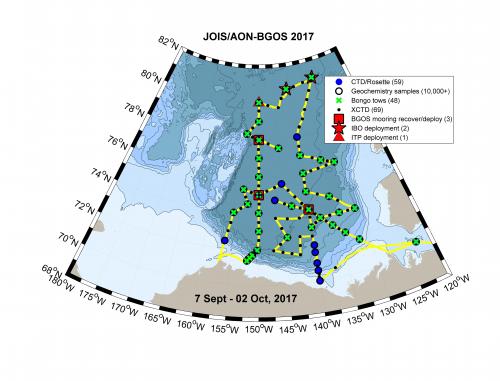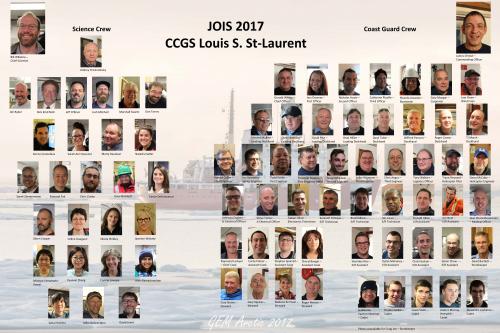Final words from Chief Scientist, cruise leader Bill Williams
A big thanks to all the science team, and the Captain and crew of the CCGS Louis S. St-Laurent. This has been a very successful 15th expedition and in very good company. Over the last month, we have covered the Beaufort Gyre with our grid of oceanographic stations, completing a huge amount of work with two ice stations, the three BGOS moorings recovered and redeployed, 69 XCTD casts, 59 CTD/Rosette casts, and 48 bongo net tows. In collecting water for geochemical analysis from the Niskin bottles on the Rosette, the day and night watches have filled over 10,000 sample bottles, most of which have been analyzed on board our team of analysts.
The ice conditions this year have been unusual, though with the loss of ice in the Arctic, unusual ice conditions in the Beaufort Gyre region are becoming expected. This year there was very little ice left by September and we needed to steam far north of our regular grid of stations to find ice that was suitable for buoy deployments. Once we returned to the open water in the ‘south’, we were able to travel faster, with no ice, but had constant concern over the potential for ocean swell to rock the ship and stop sampling. In the end we have been lucky, with only the last day of sampling where we needed to try to continue with CTD/Rosette casts during a storm with 30kt winds and 3m seas.
It is now time to take the suggestion from the westerly winds and head east back to Kugluktuk, and fly home.
Thanks again to all, until next year.
Bill Williams.
 Bill Williams with his final cruise words.
Bill Williams with his final cruise words.
 2017 expedition cruise track and completed stations.
2017 expedition cruise track and completed stations.
 JOIS 2017 CCGS Louis S. St-Laurent participants.
JOIS 2017 CCGS Louis S. St-Laurent participants.
 Dispatchers from left to right: David Jones and Andrey Proshutinsky.
Dispatchers from left to right: David Jones and Andrey Proshutinsky.
 The CCGS Sir Wilfrid Laurier in the Beaufort Sea.
The CCGS Sir Wilfrid Laurier in the Beaufort Sea.
 Wilfred Parsons helps the Science crew remove the bow boom for ice thickness measurements.
Wilfred Parsons helps the Science crew remove the bow boom for ice thickness measurements.
 Wilfred Parsons does some vertical work helping the Science crew remove the bow boom for ice thickness measurements.
Wilfred Parsons does some vertical work helping the Science crew remove the bow boom for ice thickness measurements.
 The CTD Rosette Crew poses in front of the CTD rosette sampler.
The CTD Rosette Crew poses in front of the CTD rosette sampler.

Comments
Add new comment